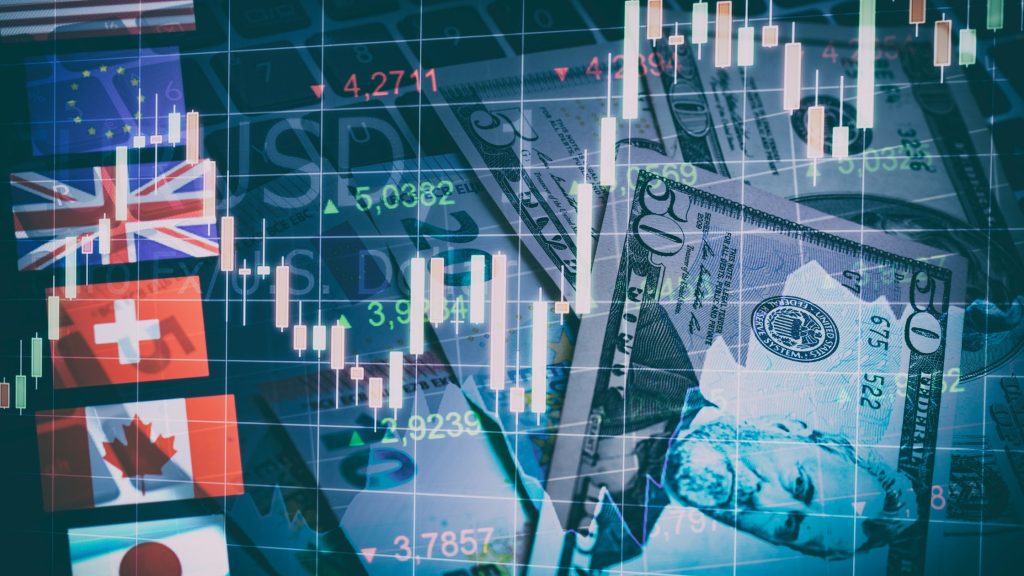What are Major Currencies in Forex Trading?
The major currencies in forex trading, also known as the “majors,” are the US dollar (USD), the euro (EUR), the Japanese yen (JPY), the British pound sterling (GBP), the Swiss franc (CHF), the Canadian dollar (CAD), the Australian dollar (AUD), and the New Zealand dollar (NZD). These currencies are considered to be the most heavily traded and have the most liquidity in the forex market. Other currencies that are commonly traded in forex include the Chinese yuan (CNY), the South Korean won (KRW), the Singapore dollar (SGD), and the Hong Kong dollar (HKD), among others.
Characteristics and Traits of Major Currencies
The Role of USD in Forex Trading
The US dollar (USD) is the most widely traded currency in the world and has several key traits and characteristics that make it unique in the forex market. Some of the main traits of the USD include:
- Reserve currency: The USD is the world’s dominant reserve currency, which means it is held in large quantities by central banks and other financial institutions around the world as a store of value.
- Liquidity: The USD is the most liquid currency in the world, which means it can be easily bought and sold in large quantities without significantly affecting its price.
- Safe-haven status: The USD is often considered a safe-haven currency, particularly during times of economic and political uncertainty, as it is perceived as a stable and reliable store of value.
- Strong economic fundamentals: The US has one of the largest and most developed economies in the world, with a stable political system and a highly developed financial sector.
- Reserve status of commodities: Many commodities, such as oil and gold, are priced in USD, which further reinforces its status as a global reserve currency.
- Impact of Federal Reserve policy: The actions of the US Federal Reserve, particularly with regard to interest rates and monetary policy, can have a significant impact on the value of the USD in the forex market.

The USD’s position as the world’s reserve currency and its strong economic fundamentals make it a major player in the forex market and a popular choice for traders around the world.
The Role of GBP in Forex Trading
The British pound sterling (GBP) is one of the major currencies in the forex market and has several key traits and characteristics that make it unique. Some of the main traits of the GBP include:
- Historical significance: The GBP has a long history dating back to the 8th century, and it has played a key role in global trade and finance for centuries.
- Second oldest currency: The GBP is the second oldest currency in the world, after the Dutch guilder, and has been in continuous use since its introduction in the 17th century.
- High liquidity: The GBP is one of the most heavily traded currencies in the forex market, with high liquidity and low spreads.
- Correlation with the Eurozone: The UK’s close economic ties with the Eurozone mean that the GBP is often influenced by events and policies in the Eurozone, particularly with regard to trade and financial regulation.
- Influence of the Bank of England: The Bank of England has a significant impact on the value of the GBP through its monetary policy decisions, including interest rates and quantitative easing.
- Political risk: The GBP is also sensitive to political risk, particularly in the context of Brexit and the ongoing negotiations between the UK and the EU over trade and financial services.
The GBP’s historical significance, high liquidity, and sensitivity to economic and political events make it a popular currency for traders in the forex market.

The Role of EUR in Forex Trading
The euro (EUR) is the second most traded currency in the world. Some of the main traits of the EUR include:
- Economic powerhouse: The euro is the currency of the Eurozone, which is one of the world’s largest economic regions, with a GDP of over €10 trillion.
- Second most traded currency: The EUR is the second most traded currency in the world, after the USD, and is widely used in international trade and finance.
- High liquidity: The EUR is highly liquid and is traded around the clock in the forex market, with low spreads and high trading volumes.
- Influence of the European Central Bank: The European Central Bank (ECB) has a significant impact on the value of the EUR through its monetary policy decisions, including interest rates and quantitative easing.
- Political risk: The EUR is sensitive to political risk, particularly with regard to the ongoing challenges facing the European Union, such as Brexit and the rise of populist movements.
- Correlation with other currencies: The EUR is often correlated with other major currencies, such as the GBP and the CHF, which can impact its value in the forex market.
The EUR’s position as a major economic and political power, combined with its high liquidity and sensitivity to global events, make it an important currency in the forex market.
The Role of AUD in Forex Trading
The Australian dollar (AUD) is also a major currency in the forex market. Some of the main traits of the AUD include:
- Commodity currency: The AUD is a commodity currency, which means its value is closely tied to the price of commodities such as iron ore, coal, and gold, which are major exports for Australia.
- High interest rates: The Reserve Bank of Australia (RBA) has traditionally maintained relatively high interest rates, which can make the AUD an attractive currency for carry traders seeking higher yields.
- Correlation with the Chinese economy: China is Australia’s largest trading partner, and as a result, the AUD is often influenced by events and policies in China, particularly with regard to commodity prices and demand.
- Political stability: Australia has a stable political system and a relatively strong economy, which can make the AUD an attractive currency for investors seeking safe-haven assets.
- High liquidity: The AUD is a highly liquid currency, with low spreads and high trading volumes in the forex market.
- Sensitivity to global risk sentiment: The AUD is often sensitive to global risk sentiment, particularly during periods of heightened market volatility and uncertainty.
The AUD’s status as a commodity currency, high interest rates, and sensitivity to events in China and global risk sentiment make it a popular choice for traders in the forex market.
The Role of NZD in Forex Trading
The New Zealand dollar (NZD) is another major currency in the forex market. Some of the main characteristics of the NZD include:
- Commodity currency: Like the Australian dollar, the NZD is a commodity currency, which means its value is closely tied to the prices of commodities such as dairy products and wood, which are major exports for New Zealand.
- High interest rates: The Reserve Bank of New Zealand (RBNZ) has traditionally maintained relatively high interest rates, which can make the NZD an attractive currency for carry traders seeking higher yields.
- High liquidity: The NZD is a highly liquid currency, with low spreads and high trading volumes in the forex market.
- Sensitivity to global risk sentiment: The NZD is often sensitive to global risk sentiment, particularly during periods of heightened market volatility and uncertainty.
- Political stability: New Zealand has a stable political system and a relatively strong economy, which can make the NZD an attractive currency for investors seeking safe-haven assets.
- Geographic isolation: New Zealand’s geographic isolation from major trading partners can make the NZD more sensitive to global economic events and trends.
The NZD’s status as a commodity currency, high interest rates, and sensitivity to global risk sentiment make it a popular choice for traders in the forex market.
The Role of CHF in Forex Trading
The Swiss franc (CHF) is a major currency in the forex market and has several key traits and characteristics that make it extremely unique:
- Safe-haven currency: The CHF is considered a safe-haven currency, which means that it tends to appreciate during times of market volatility and uncertainty. This is due in part to Switzerland’s reputation as a stable and politically neutral country.
- Low inflation: Switzerland has historically had low inflation, which can help to support the value of the CHF over time.
- High liquidity: The CHF is a highly liquid currency, with low spreads and high trading volumes in the forex market.
- Correlation with gold: The CHF has a positive correlation with the price of gold, which can impact its value in the forex market.
- Central bank intervention: The Swiss National Bank (SNB) has a history of intervening in the currency markets to manage the value of the CHF, which can create volatility in the forex market.
- Franc’s strength concerns: The franc’s strength concerns with its role as a safe-haven currency as well as its negative interest rates which can affect the economy and exports of Switzerland.
The CHF’s status as a safe-haven currency, low inflation, and high liquidity make it a popular choice for traders in the forex market. However, the SNB’s history of intervention and concerns around the franc’s strength can also create challenges for traders looking to trade the CHF.
The Role of JPY in Forex Trading
The Japanese yen (JPY) is a major currency. Some of the main traits of the JPY include:
- Safe-haven currency: The JPY is considered a safe-haven currency, which means that it tends to appreciate during times of market volatility and uncertainty. This is due in part to Japan’s reputation as a stable and economically developed country.
- Low interest rates: The Bank of Japan (BOJ) has historically maintained low interest rates, which can make the JPY a popular funding currency for carry trades.
- High liquidity: The JPY is a highly liquid currency, with low spreads and high trading volumes in the forex market.
- Trade surplus: Japan has a trade surplus, which means that it exports more goods and services than it imports. This can create demand for the JPY in the forex market.
- Correlation with global economic trends: Japan is a major exporter and is closely tied to global economic trends, which can impact the value of the JPY in the forex market.
- Central bank intervention: The BOJ has a history of intervening in the currency markets to manage the value of the JPY, which can create volatility in the forex market.
Overall, the JPY’s status as a safe-haven currency, low interest rates, and high liquidity make it a popular choice for traders in the forex market. However, its sensitivity to global economic trends and central bank intervention can also create challenges for traders looking to trade the JPY.

The Role of CAD in Forex Trading
The Canadian dollar (CAD) is a major currency in the forex market and has several key traits and characteristics that make it unique. Some of the main traits of the CAD include:
- Commodity currency: The CAD is a commodity currency, which means that its value is closely tied to the prices of commodities such as oil, natural gas, and lumber, which are major exports for Canada.
- Economic ties to the US: Canada is a major trading partner with the US, and the CAD is often influenced by economic events and trends in the US.
- Interest rates: The Bank of Canada (BOC) has historically maintained relatively high interest rates compared to other major currencies, which can make the CAD an attractive currency for carry traders seeking higher yields.
- High liquidity: The CAD is a highly liquid currency, with low spreads and high trading volumes in the forex market.
- Political stability: Canada has a stable political system and a relatively strong economy, which can make the CAD an attractive currency for investors seeking safe-haven assets.
- Correlation with risk sentiment: The CAD is often sensitive to global risk sentiment, particularly during periods of heightened market volatility and uncertainty.
The CAD’s status as a commodity currency, economic ties to the US, and relatively high interest rates make it a popular choice for traders in the forex market. Its sensitivity to global risk sentiment and correlation with commodities prices can also create opportunities and challenges for traders looking to trade the CAD.
Trading Major Currencies in Forex Trading
Understanding Major Currency Pairs and Their Characteristics
In forex trading, a currency pair is a quotation of two different currencies that are traded together in the forex market. A currency pair shows the exchange rate between the two currencies, with the base currency listed first and the quote currency listed second. For example, the EUR/USD currency pair represents the exchange rate of the euro (EUR) in terms of the US dollar (USD).
Currency pairs are the primary instruments traded in the forex market. The value of a currency pair reflects the relative strength of the base currency versus the quote currency. Forex traders buy or sell currency pairs based on their expectations of future price movements, with the aim of profiting from the price difference between the two currencies.
Understanding the traits and characteristics of major currency pairs is crucial for successful forex trading. Each currency has its unique features that can impact its value and behavior in the forex market. Factors such as economic fundamentals, central bank policies, geopolitical events, and market sentiment can all influence currency pair movements. By understanding these traits and characteristics, traders can better anticipate potential market movements and adjust their trading strategies accordingly. Failure to understand the traits of major currency pairs can lead to increased risk and potential losses in the forex market.

Utilizing Fundamental and Technical Analysis for Trading Major Currencies
Fundamental and technical analysis are two primary methods used to analyze the forex market and make trading decisions.
Fundamental analysis involves evaluating economic, financial, and geopolitical factors that can impact currency values. This includes analyzing macroeconomic indicators such as interest rates, inflation rates, GDP growth, and employment data, as well as monitoring news and events that can impact market sentiment. Fundamental analysis helps traders understand the underlying factors that can influence currency prices over the long term, and can be used to make informed trading decisions based on fundamental factors.
Technical analysis involves analyzing historical price and volume data to identify patterns and trends in the forex market. Traders use technical indicators such as moving averages, trend lines, and chart patterns to identify potential price movements and entry and exit points. Technical analysis is useful for short-term trading and can provide valuable insights into market sentiment and momentum.
Both fundamental and technical analysis can be used to trade major currencies. Traders who rely on fundamental analysis will often take a longer-term approach to trading, while those who use technical analysis may focus on shorter-term trends and price movements. Many traders use a combination of both methods to gain a more complete understanding of the forex market and make informed trading decisions.
Implementing Trading Strategies for Maximum Profitability with Major Currencies
Here are some strategies that can help traders maximize profits when trading major currencies:
- Develop a trading plan: A well-defined trading plan can help traders identify their goals, risk tolerance, and trading strategy. A trading plan should include a clear entry and exit strategy, risk management rules, and guidelines for managing emotions during trading.
- Use a combination of fundamental and technical analysis: As mentioned earlier, both fundamental and technical analysis can provide valuable insights into the forex market. Using a combination of both methods can help traders make more informed trading decisions.
- Monitor market sentiment: Market sentiment can have a significant impact on currency prices. Traders should stay up-to-date with economic news, geopolitical events, and central bank policies that can impact the forex market.
- Use risk management techniques: Trading in the forex market involves risk, and traders should always use risk management techniques such as stop-loss orders and position sizing to minimize potential losses.
- Consider using leverage: Forex brokers offer leverage, which allows traders to control larger positions with smaller amounts of capital. However, traders should use leverage with caution and avoid over-leveraging their positions.
- Maintain discipline and emotional control: Successful trading requires discipline and emotional control. Traders should avoid impulsive decisions, stick to their trading plan, and manage emotions such as fear and greed that can impact trading decisions.
Maximizing profits when trading major currencies requires a combination of technical and fundamental analysis, risk management, and emotional control. Traders who develop a well-defined trading plan, stay up-to-date with market news, and use risk management techniques can increase their chances of success in the forex market.
Factors Affecting Major Currencies in Forex Trading
Economic Indicators and Their Impact on Major Currencies
Economic indicators such as interest rates, inflation rates, GDP growth, and employment data can impact major currencies by influencing market expectations of future economic performance and central bank policies. Positive economic indicators can increase demand for a currency, while negative economic indicators can decrease demand and lead to currency depreciation.
Geopolitical Events and Their Effect on Major Currencies
Geopolitics can impact major currencies by affecting global economic and financial stability, trade relationships, and investor sentiment. Political events and decisions, such as elections, international conflicts, and policy changes, can cause uncertainty and volatility in the forex market, which can lead to fluctuations in currency values.
Conclusion
Throughout this article, we discussed various aspects of trading major currencies in the forex market. We covered the traits and characteristics of major currencies, the importance of understanding these traits when trading, and the use of fundamental and technical analysis to make informed trading decisions. We also discussed strategies for maximizing profits, including the use of risk management techniques, monitoring market sentiment, and maintaining emotional control.
Overall, trading major currencies requires a combination of knowledge, skill, and discipline. Traders who take the time to understand the underlying factors that can impact currency values and use a combination of fundamental and technical analysis can increase their chances of success.




